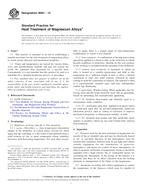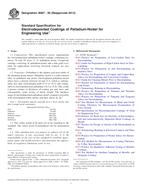1.1 This practice establishes a standard for computing the measurement uncertainty for applicable test methods in Committee D19 on Water. The practice does not provide a single-point estimate for the entire working range, but rather relates the uncertainty to concentration. The statistical technique of regression is employed during data analysis.
1.2 Applicable test methods are those whose results come from regression-based methods and whose data are intra-laboratory (not inter-laboratory data, such as result from round-robin studies). For each analysis conducted using such a method, it is assumed that a fixed, reproducible amount of sample is introduced.
1.3 Calculation of the measurement uncertainty involves the analysis of data collected to help characterize the analytical method over an appropriate concentration range. Example sources of data include: 1) calibration studies (which may or may not be conducted in pure solvent), 2) recovery studies (which typically are conducted in matrix and include all sample-preparation steps), and 3) collections of data obtained as part of the method's ongoing Quality Control program. Use of multiple instruments, multiple operators, or both, and field-sampling protocols may or may not be reflected in the data.
1.4 In any designed study whose data are to be used to calculate method uncertainty, the user should think carefully about what the study is trying to accomplish and much variation should be incorporated into the study. General guidance on designing studies (for example, calibration, recovery) is given in Appendix A. Detailed guidelines on sources of variation are outside the scope of this practice, but general points to consider are included in Appendix B, which is not intended to be exhaustive. With any study, the user must think carefully about the factors involved with conducting the analysis, and must realize that the computed measurement uncertainty will reflect the quality of the input data.
1.5 Associated with the measurement uncertainty is a user-chosen level of statistical confidence.
1.6 At any concentration in the working range, the measurement uncertainty is plus-or-minus the half-width of the prediction interval associated with the regression line.
1.7 It is assumed that the user has access to a statistical software package for performing regression. A statistician should be consulted if assistance is needed in selecting such a program.
1.8 A statistician also should be consulted if data transformations are being considered.
1.9 This standard does not purport to address all of the safety concerns, if any, associated with its use. It is the responsibility of the user of this standard to establish appropriate safety and health practices and determine the applicability of regulatory limitations prior to use.
Product Details
- Published:
- 08/01/2008
- Number of Pages:
- 7
- File Size:
- 1 file , 130 KB


